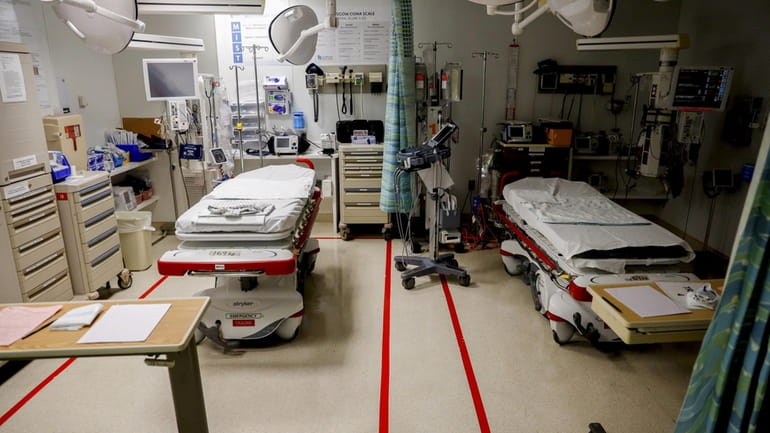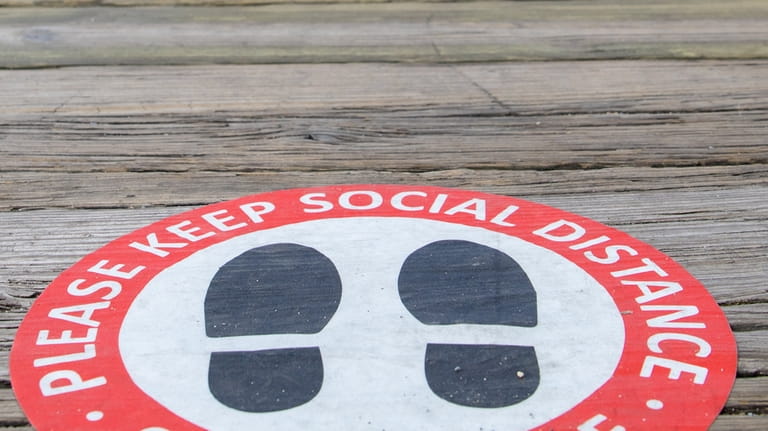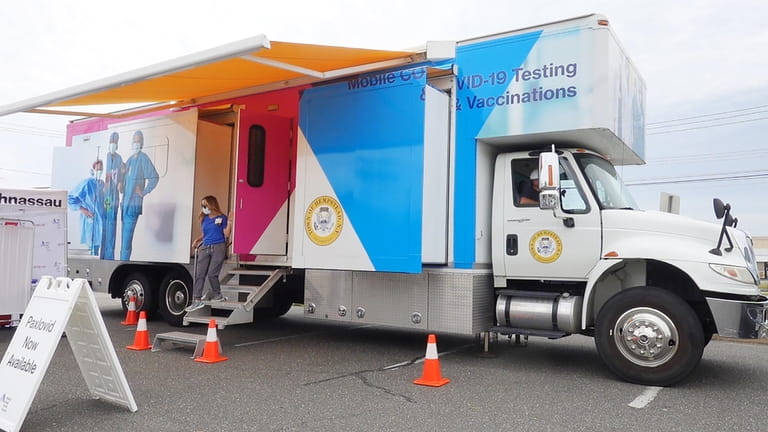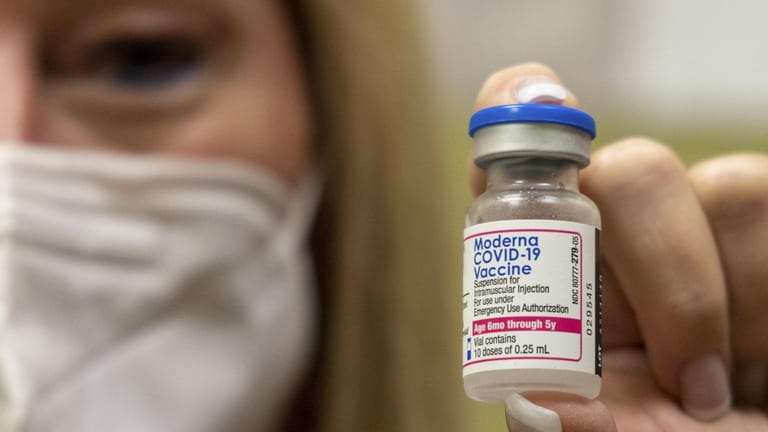COVID-19 three years later: Long Island now at 'best spot we have been in'

The mass testing and vaccine sites long have shuttered, masks are now optional, even in hospitals and nursing homes, and social distancing is becoming a distant memory.
Three years after COVID-19 first spread throughout Long Island and across the globe, life for most people has started to resemble its pre-pandemic form — filled with school activities, back-to-office and large gatherings.
There has not been a surge in COVID-19 cases, deaths and hospitalizations that marked previous seasons, giving infectious disease experts hope the disease is becoming more predictable and manageable.
“We are in the best spot we have been in since the start of the pandemic,” said Dr. Bruce Farber, chief of public health and epidemiology at Northwell Health. “Rates have continued to fall, hospitalizations remain low …
"It's way too soon to say what would happen in the fall. But for right now, I'm very cautiously optimistic.”
The past three years left a lasting mark on Long Islanders, whether they spent the first few grueling months working, hunkering down at home or battling the mysterious, new — and deadly — respiratory disease.
More than 9,000 Long Islanders have died from COVID-19. Statewide, more than 61,000 COVID-related deaths have been recorded, according to state Health Department figures.
Health officials said there were important lessons learned as they scrambled to manage hospital patient overload, find enough tests to monitor the spread of the disease, and to roll out a vaccine to health care workers and then the public.
“We know there's going to be another pandemic, whether it's mild or severe, or flu or a new virus or a coronavirus,” said Dr. Lawrence Eisenstein, who served as Nassau County health commissioner during the first years of the pandemic. “History has shown that every so often a microorganism causes quite a problem for our society. And I think we've learned that we should be prepared for that.”
Eisenstein, who is now vice president and chief public and community health officer at Catholic Health, advised individuals to become aware of health issues that could put them at greater risk during a pandemic. He added that government officials should create financial incentives to bring more nurses and others into the health care industry, which is suffering from staff shortages.
On March 11, 2020, the World Health Organization declared the coronavirus outbreak a pandemic. The NBA season was postponed, Broadway turned off its lights, and New York City's St. Patrick's Day Parade was canceled.
By April 10, Long Island’s hospitals were stretched to the limit. More than 4,000 COVID-19 patients were hospitalized. Those numbers subsided by the summer only to spike again in January 2021, when hospitalizations jumped back up to 1,701. The omicron variant produced another surge of cases, with 2,254 hospitalizations on Jan. 11, 2022.
This year, fewer than 700 COVID-19 patients were hospitalized on Long Island on Jan. 13, the highest number this winter.
The number of COVID-19 cases in New York appears to be the lowest in about a year. Only about 2% of test results recorded by the state in recent days are positive. Measuring the current level of COVID-19 in a community has become more complex, however, as more people use home tests rather than go to urgent care centers or physicians' offices, which report results to the state.
Even if the actual number of cases is much higher, health officials said the majority of people have no symptoms or a mild illness that can be treated at home. That is vastly different from the early days of the pandemic, when there were no vaccines and treatments were limited. Hospitalizations and deaths soared to a frightening level, and doctors tried to understand the new virus, known as SARS-CoV-2.
Doctors who track infectious diseases are generally reluctant to say COVID-19 has moved past the pandemic stage, which is marked by aggressive daily spread of the disease, to become an endemic, where its course is generally more predictable, such as the annual influenza season.
“Anytime someone thought we had an encouraging trend, the next thing you know, a new variant showed up and we had another surge,” said Dr. Alan Bulbin, an infectious disease specialist at Catholic Health. “I think it's probably a little more accurate this time to say these are the first real signs of what the endemic aspect of this virus's behavior really looks like going forward.”
Bulbin said if this course continues, COVID-19 is likely to fall into line with other respiratory viruses that tend to take hold in the fall and winter before they decline in the spring and summer.
Farber said a combination of immunity from both vaccines and recurrent infections has helped keep the surges down.
“Is COVID gone? No. Is COVID ever going to be gone? No,” Farber said. “Are you going to intermittently see people you know with COVID? Yes. Are they going to be in the hospital? Probably not, unless they are the small, select group of people who are immunosuppressed, elderly, totally unvaccinated and are reluctant to get treatment quickly when the diagnosis is made.”
In spring 2020, hospitals struggled to manage patients who were severely ill with COVID-19. The idea of a vaccine for this novel coronavirus seemed light-years away. But less than 12 months later, two companies had received emergency authorization from the U.S. Food and Drug Administration for their shots.
Since then, more than 230 million people in the United States, almost 70% of the population, have received their primary series of the vaccination, according to the Centers for Disease Control and Prevention.
For the Pfizer-BioNTech and Moderna vaccines, that means two shots. Booster shots followed.
Bulbin called it a “miraculous scientific achievement.”
“In record time, we were able to roll out an effective vaccine that data from Yale shows saved over 3 million lives,” he said.
But the initial positive reception to the vaccine has waned over time. Changing and sometimes confusing guidance over booster doses led fewer people to seek them out. And some people were frustrated that they still contracted COVID-19 even after getting vaccinated.
Experts contend the vaccine was never designed to completely protect against getting COVID-19, but lessen the severity of the disease to avoid hospitalization and even death.
The updated booster unveiled in September was reformulated to target some of the variants that have emerged during the pandemic. Only about 53 million, or approximately 16% of the eligible population, have received these shots.
Federal officials are considering a plan that would recommend a once-a-year COVID-19 vaccine dose for most people every fall, similar to the annual flu shot. Certain groups of people, such as those who are older and with compromised immune systems, may need additional doses.
In the early stages of the pandemic, all of the Island's available hospital spaces were transformed into COVID-19 wards. Bulbin pointed out that collaboration between health providers, government and industry was key to getting mass testing and vaccination sites up and running and accessible to as many people as possible.
“When that sort of effort is there and the power to accomplish things is there, look what happens,” he said.
State health officials said working closely with local agencies throughout the pandemic helped when they joined forces during the Mpox — formerly known as monkeypox — outbreak last year and when a case of polio was detected in Rockland County.
"We used what we had learned during COVID to be better communicators of health data both to physicians and the general public," said P. Bryon Backenson, director of the state Health Department's Bureau of Communicable Disease.
Daniel Lang, director of the state's Center for Environmental Health, pointed out the state's wastewater surveillance network developed during the pandemic as a way to monitor COVID-19 levels in the community. That network, expected to soon include 200 wastewater treatment plants, now can detect the presence of other viruses, as well as sequencing the SARS-CoV-2 virus to look for variants.
Gov. Kathy Hochul's proposed budget also includes $12 million to modernize the state’s health reporting systems and build a health monitoring and surveillance system.
The government shutdown of schools and most businesses did help overwhelmed hospitals from being completely overrun with patients, Bulbin said.
“It was tough … being able to respond to the needs of all these people with the same problem was really unique, but I think what was done basically saved the health care system from complete collapse,” Bulbin said.
Eisenstein said the pandemic put a spotlight on both the importance and shortage of health care workers, noting there should be more programs that give people incentives to pursue those careers.
“The projections on nursing shortages over the next 10 or 15 years are downright scary,” Eisenstein said.
The pandemic also highlighted the increased risks that people with underlying health issues such as diabetes and obesity face, he said. There needs to be an increased focus on preventive medicine and educating people about their risk factors, Eisenstein said.
“The trend holds true for almost everything in health care,” he said. “The higher your risk factors, the less likely you are to survive … we don’t know what the next crisis will be, but if people lower their own risk, they improve their odds.”
The mass testing and vaccine sites long have shuttered, masks are now optional, even in hospitals and nursing homes, and social distancing is becoming a distant memory.
Three years after COVID-19 first spread throughout Long Island and across the globe, life for most people has started to resemble its pre-pandemic form — filled with school activities, back-to-office and large gatherings.
There has not been a surge in COVID-19 cases, deaths and hospitalizations that marked previous seasons, giving infectious disease experts hope the disease is becoming more predictable and manageable.
“We are in the best spot we have been in since the start of the pandemic,” said Dr. Bruce Farber, chief of public health and epidemiology at Northwell Health. “Rates have continued to fall, hospitalizations remain low …
WHAT TO KNOW
- Three years after COVID-19 first spread throughout Long Island, life for most people has started to resemble its pre-pandemic form.
- This winter has almost passed without a surge in COVID-19 cases, deaths and hospitalizations, giving infectious disease experts hope the disease is becoming more predictable and manageable.
- More than 9,000 Long Islanders have died from COVID-19 since the start of the pandemic. Read the stories of five families enduring unending grief here.
"It's way too soon to say what would happen in the fall. But for right now, I'm very cautiously optimistic.”
The past three years left a lasting mark on Long Islanders, whether they spent the first few grueling months working, hunkering down at home or battling the mysterious, new — and deadly — respiratory disease.
More than 9,000 Long Islanders have died from COVID-19. Statewide, more than 61,000 COVID-related deaths have been recorded, according to state Health Department figures.
Health officials said there were important lessons learned as they scrambled to manage hospital patient overload, find enough tests to monitor the spread of the disease, and to roll out a vaccine to health care workers and then the public.

Social distancing sign in Port Jefferson in 2020. Credit: Morgan Campbell
“We know there's going to be another pandemic, whether it's mild or severe, or flu or a new virus or a coronavirus,” said Dr. Lawrence Eisenstein, who served as Nassau County health commissioner during the first years of the pandemic. “History has shown that every so often a microorganism causes quite a problem for our society. And I think we've learned that we should be prepared for that.”
Eisenstein, who is now vice president and chief public and community health officer at Catholic Health, advised individuals to become aware of health issues that could put them at greater risk during a pandemic. He added that government officials should create financial incentives to bring more nurses and others into the health care industry, which is suffering from staff shortages.
Hospitalizations, deaths down
On March 11, 2020, the World Health Organization declared the coronavirus outbreak a pandemic. The NBA season was postponed, Broadway turned off its lights, and New York City's St. Patrick's Day Parade was canceled.
By April 10, Long Island’s hospitals were stretched to the limit. More than 4,000 COVID-19 patients were hospitalized. Those numbers subsided by the summer only to spike again in January 2021, when hospitalizations jumped back up to 1,701. The omicron variant produced another surge of cases, with 2,254 hospitalizations on Jan. 11, 2022.
This year, fewer than 700 COVID-19 patients were hospitalized on Long Island on Jan. 13, the highest number this winter.
The number of COVID-19 cases in New York appears to be the lowest in about a year. Only about 2% of test results recorded by the state in recent days are positive. Measuring the current level of COVID-19 in a community has become more complex, however, as more people use home tests rather than go to urgent care centers or physicians' offices, which report results to the state.
Even if the actual number of cases is much higher, health officials said the majority of people have no symptoms or a mild illness that can be treated at home. That is vastly different from the early days of the pandemic, when there were no vaccines and treatments were limited. Hospitalizations and deaths soared to a frightening level, and doctors tried to understand the new virus, known as SARS-CoV-2.
Doctors who track infectious diseases are generally reluctant to say COVID-19 has moved past the pandemic stage, which is marked by aggressive daily spread of the disease, to become an endemic, where its course is generally more predictable, such as the annual influenza season.
“Anytime someone thought we had an encouraging trend, the next thing you know, a new variant showed up and we had another surge,” said Dr. Alan Bulbin, an infectious disease specialist at Catholic Health. “I think it's probably a little more accurate this time to say these are the first real signs of what the endemic aspect of this virus's behavior really looks like going forward.”
Bulbin said if this course continues, COVID-19 is likely to fall into line with other respiratory viruses that tend to take hold in the fall and winter before they decline in the spring and summer.
Farber said a combination of immunity from both vaccines and recurrent infections has helped keep the surges down.
“Is COVID gone? No. Is COVID ever going to be gone? No,” Farber said. “Are you going to intermittently see people you know with COVID? Yes. Are they going to be in the hospital? Probably not, unless they are the small, select group of people who are immunosuppressed, elderly, totally unvaccinated and are reluctant to get treatment quickly when the diagnosis is made.”
Vaccine 'achievement' to skepticism
In spring 2020, hospitals struggled to manage patients who were severely ill with COVID-19. The idea of a vaccine for this novel coronavirus seemed light-years away. But less than 12 months later, two companies had received emergency authorization from the U.S. Food and Drug Administration for their shots.
Since then, more than 230 million people in the United States, almost 70% of the population, have received their primary series of the vaccination, according to the Centers for Disease Control and Prevention.
For the Pfizer-BioNTech and Moderna vaccines, that means two shots. Booster shots followed.

A Mount Sinai South Nassau and Town of Hempstead Vaxmobile in July 2022. Credit: Debbie Egan-Chin
Bulbin called it a “miraculous scientific achievement.”
“In record time, we were able to roll out an effective vaccine that data from Yale shows saved over 3 million lives,” he said.
But the initial positive reception to the vaccine has waned over time. Changing and sometimes confusing guidance over booster doses led fewer people to seek them out. And some people were frustrated that they still contracted COVID-19 even after getting vaccinated.
Experts contend the vaccine was never designed to completely protect against getting COVID-19, but lessen the severity of the disease to avoid hospitalization and even death.
The updated booster unveiled in September was reformulated to target some of the variants that have emerged during the pandemic. Only about 53 million, or approximately 16% of the eligible population, have received these shots.
Federal officials are considering a plan that would recommend a once-a-year COVID-19 vaccine dose for most people every fall, similar to the annual flu shot. Certain groups of people, such as those who are older and with compromised immune systems, may need additional doses.
Preparing for the next pandemic
In the early stages of the pandemic, all of the Island's available hospital spaces were transformed into COVID-19 wards. Bulbin pointed out that collaboration between health providers, government and industry was key to getting mass testing and vaccination sites up and running and accessible to as many people as possible.
“When that sort of effort is there and the power to accomplish things is there, look what happens,” he said.

Dr. Lori Berman with a Moderna COVID-19 vaccine vial for children 6 months to 5 years old at her practice, Valley Stream Pediatrics, in 2022. Credit: Howard Schnapp
State health officials said working closely with local agencies throughout the pandemic helped when they joined forces during the Mpox — formerly known as monkeypox — outbreak last year and when a case of polio was detected in Rockland County.
"We used what we had learned during COVID to be better communicators of health data both to physicians and the general public," said P. Bryon Backenson, director of the state Health Department's Bureau of Communicable Disease.
Daniel Lang, director of the state's Center for Environmental Health, pointed out the state's wastewater surveillance network developed during the pandemic as a way to monitor COVID-19 levels in the community. That network, expected to soon include 200 wastewater treatment plants, now can detect the presence of other viruses, as well as sequencing the SARS-CoV-2 virus to look for variants.
Gov. Kathy Hochul's proposed budget also includes $12 million to modernize the state’s health reporting systems and build a health monitoring and surveillance system.
'Saved the health care system'
The government shutdown of schools and most businesses did help overwhelmed hospitals from being completely overrun with patients, Bulbin said.
“It was tough … being able to respond to the needs of all these people with the same problem was really unique, but I think what was done basically saved the health care system from complete collapse,” Bulbin said.
Eisenstein said the pandemic put a spotlight on both the importance and shortage of health care workers, noting there should be more programs that give people incentives to pursue those careers.
“The projections on nursing shortages over the next 10 or 15 years are downright scary,” Eisenstein said.
The pandemic also highlighted the increased risks that people with underlying health issues such as diabetes and obesity face, he said. There needs to be an increased focus on preventive medicine and educating people about their risk factors, Eisenstein said.
“The trend holds true for almost everything in health care,” he said. “The higher your risk factors, the less likely you are to survive … we don’t know what the next crisis will be, but if people lower their own risk, they improve their odds.”

